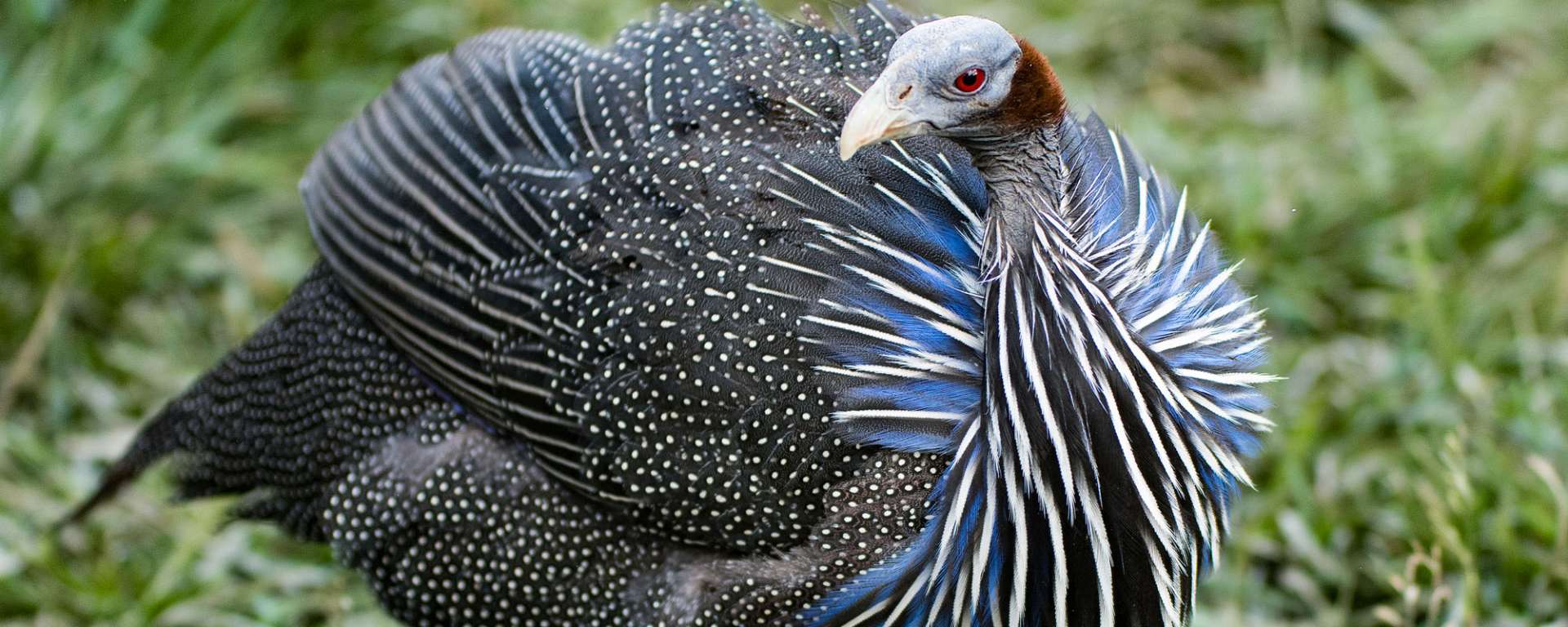Description
The vulturine is the largest guineafowl, with a noticeably long neck. The bare skin on the head and neck is a bluish-grey color. There is a reddish brown down on the back of the head and nape of the neck. Chest feathers are a bright blue color; the back is dark grey with white spots. Males and females look similar, though females are a little smaller. They have one or more “spurs” on the tarsus, the part of the leg below the backwards facing “knee” and the “ankle”. Juveniles are less brightly colored than adults.
Classification
- Class
- Aves
- Order
- Galliformes
- Family
- Numidae
- Genus
- Acryllium
- Species
- A. vulturinum
- Conservation Status
- Least Concern
The IUCN classifies Acryllium vulturinum as a species of Least Concern.
Social Life
Vulturine guineafowl are gregarious and live in flocks of up to 25 birds. They are sedentary (do not migrate) but they do travel a habitual local route in search of food.
Habitat and Range
Vulturine guineafowl are found in East central Africa (Ethiopia, Kenya, Somalia, and Tanzania). The are typically found in drier and more open habitats (like thorn scrub and savanna) than other guineafowl species.
Diet
Like helmeted guineafowl, vulturine guineafowl are opportunistic omnivores, eating insects, small mollusks, spiders, scorpions, seeds and leaves, berries, and so on. They forage on the ground, only rarely climbing into bushes to get berries or leaves. Unlike other guineafowl, Vulturine Guineafowl do not appear to need water; even when it is available they often do not drink.
Lifespan
12-15 years.
Predators
Various monkeys, genets, and wild cats often steal the eggs, and the cats may also kill an adult guineafowl. Chicks can be taken by Black Crows or Lanner Falcons.
Reproduction
Males and females form a monogamous pair.
Sexual Maturity: 2 years
Mating Season: During or just after the rainy season. The family group merges back into the flock after breeding season is over.
Incubation and Fledging: 23-25 days. The female incubates the eggs at night, and the male during the daytime. When the chicks hatch they are covered in yellowish down feathers with brown spots. Chicks are precocial and are able to leave the nest almost immediately. The parents protect and guide the chicks for the first 15-20 days, until they are able to fly up into trees to roost at night.
No. of Young: The female lays a clutch of 12- 15 creamy white or pale brown eggs. The nest is usually a simple scrape on the ground.
- Information
-
Description
The vulturine is the largest guineafowl, with a noticeably long neck. The bare skin on the head and neck is a bluish-grey color. There is a reddish brown down on the back of the head and nape of the neck. Chest feathers are a bright blue color; the back is dark grey with white spots. Males and females look similar, though females are a little smaller. They have one or more “spurs” on the tarsus, the part of the leg below the backwards facing “knee” and the “ankle”. Juveniles are less brightly colored than adults.
Classification
- Class
- Aves
- Order
- Galliformes
- Family
- Numidae
- Genus
- Acryllium
- Species
- A. vulturinum
- Conservation Status
- Least Concern
- Conservation
The IUCN classifies Acryllium vulturinum as a species of Least Concern.
- Lifestyle
Social Life
Vulturine guineafowl are gregarious and live in flocks of up to 25 birds. They are sedentary (do not migrate) but they do travel a habitual local route in search of food.Habitat and Range
Vulturine guineafowl are found in East central Africa (Ethiopia, Kenya, Somalia, and Tanzania). The are typically found in drier and more open habitats (like thorn scrub and savanna) than other guineafowl species.Diet
Like helmeted guineafowl, vulturine guineafowl are opportunistic omnivores, eating insects, small mollusks, spiders, scorpions, seeds and leaves, berries, and so on. They forage on the ground, only rarely climbing into bushes to get berries or leaves. Unlike other guineafowl, Vulturine Guineafowl do not appear to need water; even when it is available they often do not drink.Lifespan
12-15 years.Predators
Various monkeys, genets, and wild cats often steal the eggs, and the cats may also kill an adult guineafowl. Chicks can be taken by Black Crows or Lanner Falcons.Reproduction
Males and females form a monogamous pair.
Sexual Maturity: 2 years
Mating Season: During or just after the rainy season. The family group merges back into the flock after breeding season is over.
Incubation and Fledging: 23-25 days. The female incubates the eggs at night, and the male during the daytime. When the chicks hatch they are covered in yellowish down feathers with brown spots. Chicks are precocial and are able to leave the nest almost immediately. The parents protect and guide the chicks for the first 15-20 days, until they are able to fly up into trees to roost at night.
No. of Young: The female lays a clutch of 12- 15 creamy white or pale brown eggs. The nest is usually a simple scrape on the ground.

